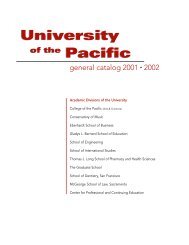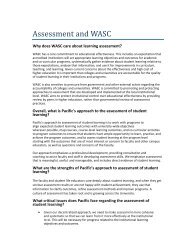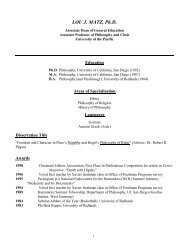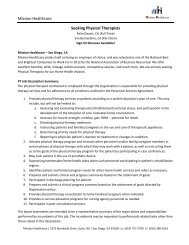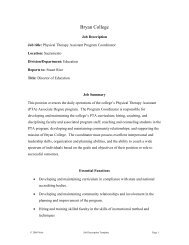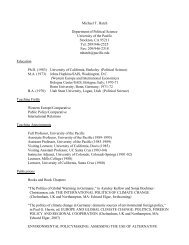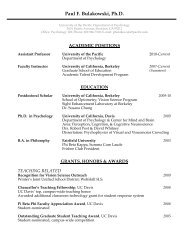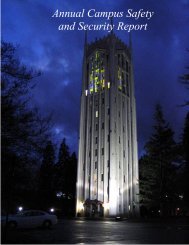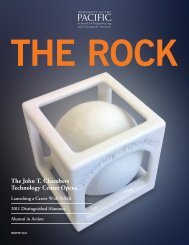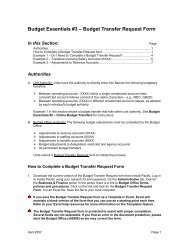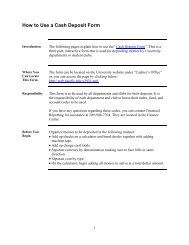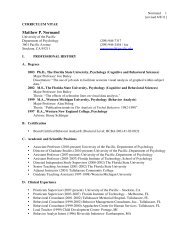purcc 2012 - University of the Pacific
purcc 2012 - University of the Pacific
purcc 2012 - University of the Pacific
Create successful ePaper yourself
Turn your PDF publications into a flip-book with our unique Google optimized e-Paper software.
Poster Session Abstracts<br />
Some <strong>of</strong> <strong>the</strong>se compounds are so complex that<br />
measurements for acidity and basicity cannot be<br />
carried out experimentally. For this reason,<br />
molecular modeling calculations are used to<br />
determine <strong>the</strong> <strong>the</strong>oretical value. Spartan and<br />
Gaussian were <strong>the</strong> computational programs that<br />
were used to determine <strong>the</strong> three dimensional<br />
structure <strong>of</strong> <strong>the</strong> organic compounds. From <strong>the</strong>re,<br />
various calculations were carried out to<br />
determine <strong>the</strong> acidity and basicity. The<br />
<strong>the</strong>oretical values were compared with<br />
experimental data for known compounds to<br />
evaluate <strong>the</strong> method. The results showed that <strong>the</strong><br />
<strong>the</strong>oretical values directly correlated with <strong>the</strong><br />
experimental data.<br />
Syn<strong>the</strong>sis <strong>of</strong> Polypeptides and Cleavage<br />
Rajneet Padda<br />
Faculty Mentor: Jianhua Ren<br />
Polypeptides are short polymers that contain<br />
amino acid residues and are linked by a<br />
peptide bond. The peptide bonds correlate with<br />
<strong>the</strong> secondary structure <strong>of</strong> proteins, which are<br />
ei<strong>the</strong>r alpha helices or Beta sheets. Changing<br />
an amino acid residue in a primary structure<br />
can change <strong>the</strong> way a protein folds; <strong>the</strong>refore,<br />
affecting <strong>the</strong> function <strong>of</strong> <strong>the</strong> protein. In order<br />
to understand how <strong>the</strong> primary structure can<br />
affect <strong>the</strong> protein folding, it is extremely<br />
important to understand <strong>the</strong> chemical<br />
properties <strong>of</strong> polypeptides<br />
In this research various peptides are<br />
syn<strong>the</strong>sized using <strong>the</strong> Solid Phase Peptide<br />
Syn<strong>the</strong>sis. In this procedure amino acids are<br />
attached to Rink Amide resins one at a time<br />
until <strong>the</strong> peptide <strong>of</strong> choice is syn<strong>the</strong>sized. Then<br />
<strong>the</strong> peptide is cleaved from <strong>the</strong> resins using a<br />
cleavage reagent. In order to obtain a peptide<br />
with high yield and high purity, <strong>the</strong> right<br />
cleavage reagent must be used. For Cys-Ala-<br />
Ala-Ala and Ala-Ala-Ala-Cys peptides, three<br />
cleavage reagents have been tested in our lab:<br />
TFA and Reagent R, and Reagent B. The<br />
results from <strong>the</strong> three cleavage reagents will be<br />
presented in <strong>the</strong> poster.<br />
Expression and gene modification <strong>of</strong> Taqpolymerase<br />
using <strong>the</strong> SUMO purification<br />
system<br />
Juan Manuel Abundes, Elaina Khoo, Lifang<br />
Zhou, Jennifer Ou, Felicia Resendez,<br />
Hyungsuk Lee, Christina Quach<br />
Faculty Mentor: Jerry Tsai<br />
Taq DNA polymerase is an enzyme produced by<br />
<strong>the</strong> <strong>the</strong>rmophilic bacterium Thermus aquaticus,<br />
which is commonly used to amplify DNA in <strong>the</strong><br />
polymerase chain reaction (PCR). The enzyme’s<br />
unique ability to withstand high temperatures,<br />
36-75°C, makes it an efficient enzyme for cycles<br />
<strong>of</strong> heating and cooling. Purification <strong>of</strong> Taq<br />
polymerase can be done through heat lysis.<br />
While this is adequate for general use, this<br />
method produced an impure Taq polymerase<br />
mixed with o<strong>the</strong>r contaminating proteins. The<br />
impurities make it difficult to only study Taq<br />
polymers. With this in mind, an improved<br />
purification method was employed that<br />
combined <strong>the</strong> affinity tag <strong>of</strong> histidines along with<br />
<strong>the</strong> small ubiquitin-related modifier (SUMO)<br />
gene. This histidine tag <strong>of</strong> <strong>the</strong> SUMO system is<br />
an ideal purification technique for Taq<br />
polymerase due to <strong>the</strong> tag’s affinity to nickel. It<br />
was proposed that cloning <strong>the</strong> Taq gene into <strong>the</strong><br />
SUMO expression system would facilitate easy<br />
purification. SUMO modulates protein structure<br />
and function by binding to <strong>the</strong> lysine side chains<br />
<strong>of</strong> target proteins. The Taq polymerase gene is<br />
cloned onto <strong>the</strong> C-terminal end <strong>of</strong> <strong>the</strong> SUMO<br />
gene using a PCR approach. Specific DNA<br />
primers were designed to introduce <strong>the</strong> excised<br />
Taq gene into <strong>the</strong> proper vector. Then, by<br />
inducing <strong>the</strong> bacterium, Escherichia coli (E. coli)<br />
with this gene, <strong>the</strong> Sumo-Taq protein can be<br />
expressed, to later be isolated using affinity<br />
chromatography involving <strong>the</strong> Nickel resin. Taq<br />
polymerase alone can be isolated by flowing<br />
SUMO protease through <strong>the</strong> column, resulting in<br />
simple and homogenous purification <strong>of</strong> this<br />
protein.<br />
Adventures in New Metal Complexes<br />
Design and Syn<strong>the</strong>sis<br />
Una Lee, Sirena Lau, Vickie Nguyen,<br />
Sarah Chiu<br />
Faculty Mentor: Qinliang Zhao<br />
Yi-Ju Tsai (graduate student)<br />
Functionalization <strong>of</strong> an organic molecule <strong>of</strong>ten<br />
involves C-H bond activation. However, <strong>the</strong><br />
61



